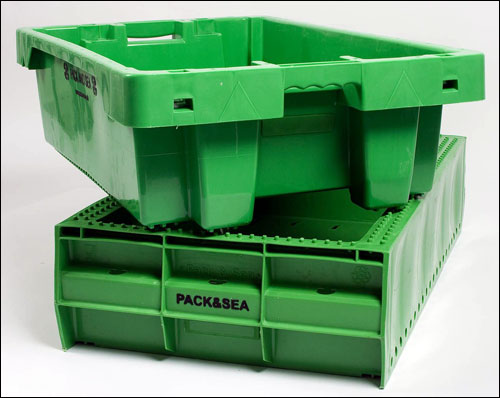Pack and Sea, a Danish company that leases crates to the fishing industry, is employing radio frequency identification to track the locations of its plastic crates. The containers hold fish as they are caught at sea, and later as they are sold at market. The system allows the firm to reduce the loss and theft of its crates, and to bill the appropriate party in the event that the reusable containers are not returned.
The system, provided by Scandinavian RFID integration company ProSign, utilizes handheld and fixed interrogators from Alien Technology, as well as Alien EPC Gen 2 passive ultrahigh-frequency (UHF) tags attached to the crates.
Pack and Sea leases hundreds of thousands of crates to fishermen, who load them onto ships plying the North Sea, fill the containers with their catch, and then deliver them to auction houses in Denmark or other European countries. If the system works as intended, the crates are leased, filled with fish and brought to auction houses or buyers, who can then distribute and sell the catch, and return the crates to Pack and Sea so that they can be washed and reused.
The company had relied mainly on a manual method of tracking its containers, using pen and paper to record the number of crates a fisherman, auction house or buyer has at any given time, along with when they need to be returned. However, says ProSign’s CEO, Michael Jensen, on a trip through Poland in 2009, he and Pack and Sea’s staff traveled through ports and identified enough abandoned Pack and Sea crates to fill two trucks. On average, in fact, 5 percent to 10 percent of the company’s crates are lost each year.
Pack and Sea thus required a solution that would increase the chances of its crates being returned, and that would also enable it to know whom to bill when containers are missing.
Before going out to sea, a fisherman goes to Pack and Sea and rents crates. The required number of containers are taken out of the company’s storage area and assigned to that fisherman, who then loads them onto his boat and sails out. Upon catching fish, a mariner has two options: either using the crates for storing his catch without sorting the fish, and then delivering them to an onshore facility that does the sorting for him—or, more commonly, sorting them at sea based on species, sizes and qualities.
With the latter option, when the ship returns to the harbor, the loaded crates are delivered directly to an auction house, to be sold. The fish then travel to the buyer’s factory for processing, or are exported to other European countries. In the first scenario (in which a variety of fish are packed in the same container), the crates have an added step—passing from the sorting company to the auction house for sale. On the boat, as well as in the harbor, the crates are stored in cooling rooms and freezers. When the containers are emptied, Jensen says, it is the responsibility of the factory or other party in possession of those crates to return them to one of Pack and Sea’s locations in Denmark, where they are cleaned in a high-pressure, high-temperature washing machine before being placed into storage again.
There are several ways in which the crates can go missing: They can be stolen from the storage area, or from the companies processing the fish, they can fall overboard at sea, or fishermen can deliver their catch to a facility that then holds onto the containers. In addition, some are damaged during handling. The fishermen, the factories and the exporters pay a fee to rent each crate, and if Pack and Sea is aware that they are not returned, it will continue to charge that fee until the crate is fully paid for, assuming it can ascertain the party responsible.
In 2006, Pack and Sea began seeking a better solution. The firm began working with ProSign, which helped it conduct pilots in 2007 and 2008, in search of the best way to tag the crates, as well as the optimal RFID tags for the application. The fish industry can be hard on RFID tags, the company reports. The crates can experience temperatures fluctuating from -20 degrees Celsius (-4 degrees Fahrenheit) when out at sea or in freezers, to +70 or +80 degrees Celsius (+158 or +176 degrees Fahrenheit) in the washing unit. The containers are exposed to water, corrosive salt and shock, due to being dropped or banged against other crates on the trucks or ships. Therefore, the company tested various makes and models of RFID tags, and chose the tag that performed best in those conditions—a UHF Gen 2 EPC Alien Higgs-3 Squiggle tag, encased in a protective plastic housing. The tags are now successfully operating under the harsh conditions, Jensen says.
Pack and Sea has begun manufacturing new crates to replace old containers that were less uniform and, thus, less stackable with those from other companies that lease similar crates. With the arrival of each new crate, the company attaches an RFID tag by welding its plastic housing onto that container, and then retires the old, un-tagged crate. The firm is currently in the process of tagging several hundred thousand crates at approximately 10 facilities throughout Denmark. It has also installed fixed RFID readers in portals in storage yards and in washing units, and has deployed handheld interrogators to its employees.
With the new system, when a fisherman leases a specific number of crates, Pack and Sea’s workers retrieve the containers from the storage area and read the unique ID number encoded to each crate’s tag, either with a handheld reader or the fixed interrogator, while driving with a truckload of crates through a portal at the storage yard. The fisherman’s account information is entered into Pack and Sea’s back-end system and linked with those RFID numbers, and he is then billed accordingly. When the crates are brought back from sea containing fish, the ID numbers encoded to the containers’ tags are read by auction or sorting staff members using handheld readers. After each read is accomplished, that crate’s status is automatically updated in Pack and Sea’s software, thus recording who is currently in possession. If the container’s contents are then sold, the tags are read once more, indicating the fish-buying company now responsible for the crates.
When the fish in the crates are processed and the containers are emptied, they are shipped back to Pack and Sea, where a fixed reader at the washer captures the tags’ ID numbers once more, and then updates the crates’ status as “returned.”
Later in 2010, Jensen says, the crate-leasing company intends to launch a pilot program that would provide RFID readers that fishermen could take with them onboard a ship. “We will start pilots with handheld and stationary readers [connected to] weighing devices,” he states. Once caught, the fish would be sorted and placed in crates, and the containers would be weighed. At the same time, the interrogator would capture each crate’s ID number and link that container with the specific catch and its weight, and the data could then be sent via a satellite connection to the particular auction house to which the fish is to be delivered, thereby alerting it as to what it can expect to receive its shipment.
The process could also be managed with a handheld interrogator, by reading the ID tag as the loaded crate is being weighed, and by using a keypad to manually input such information as the type of fish, the location of the catch and its weight. When the ship delivers the crate, the tag would be read, and the auction house could then link that container with specific data regarding what is contained within (the type of fish and weight, as well as the date, time and location of the catch). Based on the success of those handheld and fixed reader pilots on boats, Pack and Sea hopes to make the system permanently available to fishermen in 2011 or 2012.



